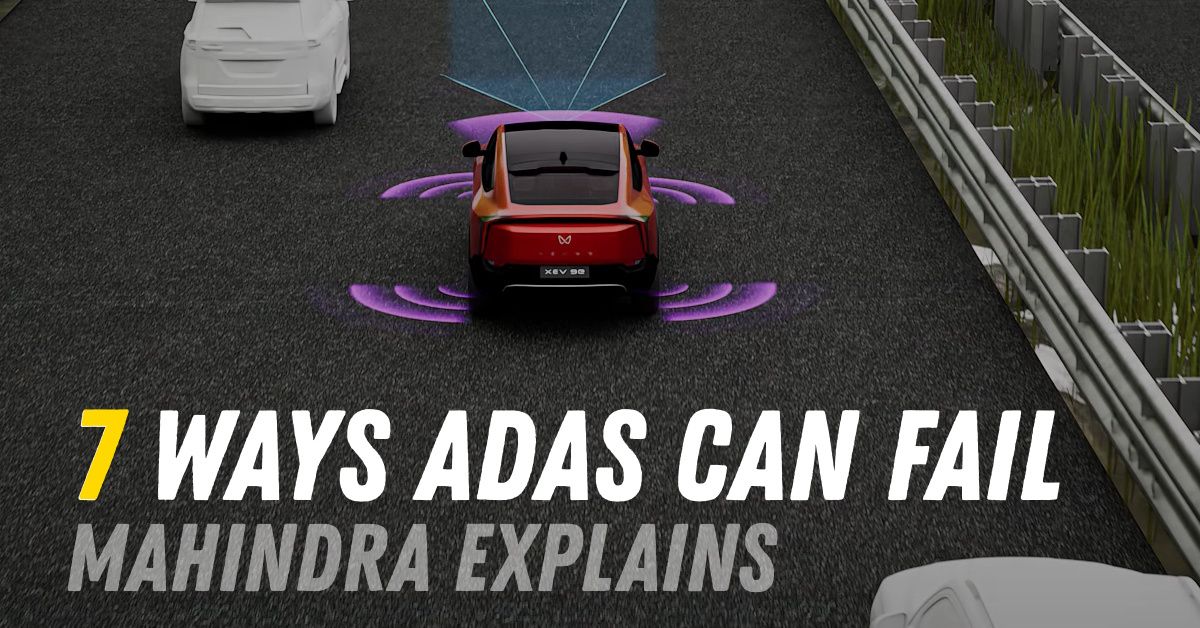Seven Ways ADAS Can Fail According to Mahindra


Mahindra’s new electric SUVs, the BE6 and XUV 9e, come packed with advanced safety tech, including Level 2+ ADAS (Advanced Driver Assistance Systems). These systems use five radars, multiple sensors, and cameras to help drivers stay safe on the road. But surprisingly, Mahindra is also openly talking about where this technology can go wrong. Through detailed educational videos, the company is warning users that these systems aren’t perfect and that drivers still need to be alert. Here are the seven key ways ADAS can fail, as explained by Mahindra.
The system can miss vehicles approaching at sharp angles. If a car enters your path at more than 20 degrees from either side, the ADAS may not register it. This is risky at junctions or roundabouts, where vehicles often approach from odd directions.
It also struggles when another vehicle suddenly changes lanes and cuts in front. On highways, where drivers often switch lanes quickly, this can be dangerous. The automatic emergency braking might not act in time.
Rain, fog, and low sunlight can seriously affect how well the cameras and sensors work. For example, tests have shown that in moderate to heavy rain, emergency braking systems crash into stopped cars 33% of the time at 35 mph. Lane-keeping systems are even worse in such weather, failing to stay in the lane nearly 70% of the time.
Night driving is also a problem. If the vehicle ahead has broken or dim tail-lights, the system may not work well. This is a big concern because most pedestrian deaths happen after dark, when these systems are supposed to help the most.
The system is not very good at reacting when a person suddenly jumps in front of the car. If someone runs onto the road or is partly hidden (by a bag or an umbrella), the sensors may not see them clearly or in time.
Children are also harder to detect due to their height. While large animals like cows can be detected, smaller animals like cats may go unnoticed, increasing the risk of accidents.
One major flaw is that the system does not detect speed bumps. So, drivers have to slow down manually every time. It also cannot see temporary roadblocks or construction barriers. That means if there’s debris, a parked car, or an obstacle on the road, and it's not in a perfect line with the car’s sensors, it may be completely ignored.
The adaptive cruise control (ACC) system doesn’t detect when another vehicle suddenly enters your lane or when there are stationary objects ahead. This makes it unreliable in city traffic or on busy highways. It also cannot see animals, cyclists, or motorbikes in tight traffic, making it unsafe in many everyday situations.
The lane-keeping system depends on clearly visible white lines on the road. If the lines are faded or missing—like on newly built roads or in rural areas—the system fails to work. It also struggles with sharp bends and during low visibility, like in fog or heavy rain.
Heavy rain affects many ADAS features all at once. For example, in wet conditions, emergency braking can still cause crashes nearly one-third of the time. Snow and ice can block sensors and cameras, making them useless just when road conditions are most dangerous.
Even a little dirt, slush, or mud on a sensor can cause the whole safety system to stop working. That means regular cleaning and maintenance are critical, but drivers might not always know when something is wrong.
Mahindra is being honest about a truth many carmakers avoid: ADAS is helpful, but it is not a replacement for careful driving. The brand’s “Human + Machine” approach reminds users that staying alert is still the best safety feature. Some users have even tried stunts on social media using these vehicles, which shows how important it is to understand the limits of these systems.
ADAS has come a long way and can make driving safer, but it still has flaws. Mahindra’s clear messaging helps drivers understand what the system can and cannot do. Knowing these seven failure points helps users get the best out of the technology while staying fully in control behind the wheel.